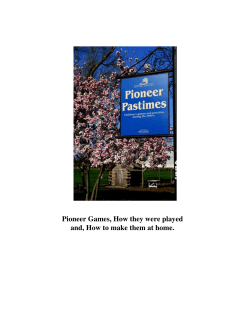
white paper - Bay Area Video Coalition
LESSONS FROM GIG UNION: HOW 'SMALL DATA' CAN FORECAST THE FUTURE OF FREELANCING ABOUT BAVC For all of its 39 years, BAVC has served independent media makers. Since 1976, what it means to be an “independent media maker” has changed almost as quickly as the technology that made that vocation possible. What BAVC has seen over the years, however, is that creative technologists and independent media makers are self-driven, hard working, resourceful, and motivated. They want the flexibility that comes from working outside of a traditional office setting, and they will do what it takes to make that life – and the personal creative projects they love – possible. In 2012 when BAVC was awarded support from the Department of Labor through the San Francisco Office of Economic & Workforce Development (OEWD) to assist freelancers working in media and technology with developing entrepreneurial skills, we knew we had a chance to provide services for those dedicated to making their own rules at a crucial juncture. The tools for media and technology production and the platforms for distruption change almost daily, and entire industries built upon specialized skills, knowledge, and modes of production (print journalism, documentary film, graphic and information design, television production, computer engineering, and more) are crumbling, being reimagined, falling, and rising again with little stability on the near horizon. In this shifting landscape, with OEWD support, BAVC launched its newest initiative for media and technology freelancers, Gig Union. Now on the verge of closing out its third program year, Gig Union serves more than 600 members through a variety of events, workshops and classes, in addition to providing a freelance resource Wiki and job placement connections. As BAVC closes out its formal support from the City and considers the role of a resource like Gig Union moving forward, we took some time to look at Gig Union’s membership and what lessons we can all learn from who BAVC is serving, how the economy and growth of contract work is changin the workforce playing field, and what we all need to consider as we prepare for the biggest shift in how Americans work since the industrial revolution. OVERVIEW OF FINDINGS What did we find when we looked at the numbers? Well, as Charles Dickens wrote in the middle of the 19th century: “It was the best of times, it was the worst of times.” Of Gig Union members, the majority (80%) are in their 30s and 40s, with a growing number in their 20s. Most (80%) have a college or graduate school education. 1 80% 30-40 GIG UNION MEMBERS YEARS OLD OF GIG UNION 83% MEMBERS DON’T HAVE CONSISTENT CLIENTS 80% COLLEGE OR GRADUATE SCHOOL LEVEL EDUCATION And most (83%) reveal that their biggest concern is finding their next client, with 30% reporting that their typical contract job lasts no more than one week. Yet when asked if they had a business plan, the vast majority (94%) said either that they did not, or that they simply planned to connect with friends and former clients to bring in new clients. To date, fewer than 10% have taken advantage of programs like T M T M W W TH F TH “Freelancing is a Business” and “Freelance Contract F M T W TH F M T W TH F 30% OF GIG UNION MEMBERS REPORT THEIR TYPICAL CONTRACT JOB LASTS ONLY ONE WEEK. Negotiation”. When offered a series of options to address their needs as freelancers, the majority chose networking events (33%) and portfolio review sessions (19%). Over 2.5 years, however, placements in contract positions for Gig Union members increased steadily, with self-reported placements in contract positions increasing by more than 80% from October 2013 to October 2014. This rise in placement for contract workers is something that BAVC has seen across industries, and is one of the reasons we’re holding the WorkShift 2020 discussion. 94% OF GIG UNION MEMBERS DO NOT HAVE A BUSINESS PLAN If more and more people are choosing to become contract workers, while simultaneously more people are becoming contract workers because of industry forces. Where does this leave the American workforce in general, and moreover, where does it leave the American worker? 2 BY THE NUMBERS The members of Gig Union closely reflect the overall demographics of San Francisco: AGE GENDER 4% 70s 4% 20s 46% women 1% 60s 15% 50s 40% 30s 2% trans 36% 40s 3% chose not to answer 8% Hispanic ETHNICITY 5% Other 10% African American 61% White 16% Asian EDUCATION 53% 4 year degree 49% men 25% Post-Graduate Degree 2% Partial Credit Towards Post-Graduate Degree 2% High School Graduate 7% Some College *Statistics in this report are drawn from surveys of BAVC's 600+ Gig Union members. 2% A.A. Degree From Community College 3 Although they are often highly educated, people moving into the media and creative technology sector as entrepreneurial freelance contractors are unfamiliar with the business-related requirements that are necessary to make it in this new economy. More than 78% surveyed say that they “consider themselves contractors” – meaning that freelance, contract work is their primary way of earning income – and the greatest number have been proprietors of their own business for at least three years (40%). Every Gig Union member has significant technical skill, and a portfolio that showcases those skills in some way. A challenge for members, however, is understanding how to charge for their services; members reported wildly different ideas of how much their labor is worth. When asked how much they hope to earn as full-time freelancers, 20% answered $40-$50,000 annually, 17% answered $50-$60,000, and 15% answered $90-$100,000. NUMBER OF YEARS IN BUSINESS 20% other 41% in business 3 years 11% in business less than 6 months 20% in business 1-2 years GREATEST CONCERN AS A FREELANCER 8% in business less than a year INCOME EXPECTATIONS 83% Can not find consistent clients 15% $90 - $100,000 63% Unrecognized branding 17% $50 - $60,000 60% Need for networking opportunities 20% $40 - $50,000 *Statistics in this report are drawn from surveys of BAVC's 600+ Gig Union members. 4 RECOMMENDATIONS Very much in keeping with the state of online media itself in 2015, there is no shortage of media creators (from journalists to video producers to designers) who have skills and can create quality content and products. And also very much like online media itself, there are myriad ways to access media creators (individual portfolio sites, group portfolio sites, LinkedIn). But just as we look, out of necessity, for platforms that curate our content so we can find what we need in an efficient manner, we are also in need of solutions that showcase talent in the creative media and technology sector and make it easier for those in the position to hire to be able to locate talent. For those who are the creators of media and technology solutions, there are ways to shift our workforce services to help freelancers: • understand how to reach potential employers, • create a sustainable business model, and • work together to share resources and make their voices heard Together, these efforts will make our Bay Area community – and as the nation follows, the country – more resilient. Beyond platforms, there is clearly a need for improved education. It is liberating to not be tied to a traditional 9-5 job. With that freedom comes unexpected challenges, especially for those with a college or Master’s degree and technical skills but who lack an understanding of how to function within an entrepreneurial framework. If a contractor is in her or his 30s or 40s, it’s likely that s/he has spent a decade working within a corporate structure, without the need to consider important, capital-intensive decisions like healthcare options and self-employment taxes, nevermind effective marketing and business plan development. This leads to important questions for us as a society: • How do we educate current and new generations of workers to think entrepreneurially within or outside of a traditional work setting? • When we think about media workers, many of whom produce the news stories and information we rely on to make democratic decisions, how can we ensure that they can spend more of their time creating work and less time scrambling for new clients? • With no commonly shared resource for freelancers to determine the worth of their work, how do contract-based workers move toward collaboration and information sharing that will raise them up rather than leave them leaving them in a race to the bottom of the wage scale? 5 • If policies related to training, workforce development initiatives, and labor laws are aligned with ways of working that are already in many ways obsolete, is it too late to institute policies that will support workers while meeting the needs of industry? In short, there is a need to make systemic changes at the educational, workplace, and workforce levels so that we avert what could very well be a crisis in labor that leaves workers isolated and in an insecure financial position. And there is a need to educate employers about the burgeoning freelance field that includes the tools to locate the best workers for the myriad positions that are available now and will soon become available. For nearly five years, as a nation we’ve talked about the power of “big data,” but it is, BAVC believes, the small data – like that from the hundreds of Gig Union members we serve, that can help to mold small and large changes in program and policy that will eventually mean greater, systemic change. As a freelancer resource, BAVC will focus its efforts on helping contract-based workers build sustainable business plans, keep abreast of industry trends, and develop the marketing skills and networks they need to move from one job to the next. Collectively, in order to serve the greatest number of contract-based workers, we need to create programs and infrastructure locally, regionally, and nationally that will grow the nation’s entrepreneurial workforce while better connecting them to one another for a sustainable economy that supports worker and employer alike. Bay Area Video Coalition. This publication is copyright. Apart from any use as permitted under the Copyright Act 1968, no part may be reproduced in any form without written permission from Bay Area Video Coalition. 6
© Copyright 2025










